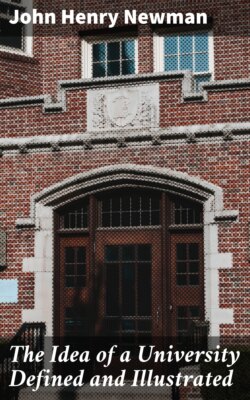Читать книгу The Idea of a University Defined and Illustrated - John Henry Newman - Страница 40
На сайте Литреса книга снята с продажи.
5.
ОглавлениеTable of Contents
And now I have said enough to explain the inconvenience which I conceive necessarily to result from a refusal to recognize theological truth in a course of Universal Knowledge;—it is not only the loss of Theology, it is the perversion of other sciences. What it unjustly forfeits, others unjustly seize. They have their own department, and, in going out of it, attempt to do what they really cannot do; and that the more mischievously, because they do teach what in its place is true, though when out of its place, perverted or carried to excess, it is not true. And, as every man has not the capacity of separating truth from falsehood, they persuade the world of what is false by urging upon it what is true. Nor is it open enemies alone who encounter us here, sometimes it is friends, sometimes persons who, if not friends, at least have no wish to oppose Religion, and are not conscious they are doing so; and it will carry out my meaning more fully if I give some illustrations of it.
As to friends, I may take as an instance the cultivation of the Fine Arts, Painting, Sculpture, Architecture, to which I may add Music. These high ministers of the Beautiful and the Noble are, it is plain, special attendants and handmaids of Religion; but it is equally plain that they are apt to forget their place, and, unless restrained with a firm hand, instead of being servants, will aim at becoming principals. Here lies the advantage, in an ecclesiastical point of view, of their more rudimental state, I mean of the ancient style of architecture, of Gothic [pg 079] sculpture and painting, and of what is called Gregorian music, that these inchoate sciences have so little innate vigour and life in them, that they are in no danger of going out of their place, and giving the law to Religion. But the case is very different when genius has breathed upon their natural elements, and has developed them into what I may call intellectual powers. When Painting, for example, grows into the fulness of its function as a simply imitative art, it at once ceases to be a dependant on the Church. It has an end of its own, and that of earth: Nature is its pattern, and the object it pursues is the beauty of Nature, even till it becomes an ideal beauty, but a natural beauty still. It cannot imitate that beauty of Angels and Saints which it has never seen. At first, indeed, by outlines and emblems it shadowed out the Invisible, and its want of skill became the instrument of reverence and modesty; but as time went on and it attained its full dimensions as an art, it rather subjected Religion to its own ends than ministered to the ends of Religion, and in its long galleries and stately chambers, did but mingle adorable figures and sacred histories with a multitude of earthly, not to say unseemly forms, which the Art had created, borrowing withal a colouring and a character from that bad company. Not content with neutral ground for its development, it was attracted by the sublimity of divine subjects to ambitious and hazardous essays. Without my saying a word more, you will clearly understand, Gentlemen, that under these circumstances Religion was bound to exert itself, that the world might not gain an advantage over it. Put out of sight the severe teaching of Catholicism in the schools of Painting, as men now would put it aside in their philosophical studies, and in no long time you would have the hierarchy of the Church, the Anchorite and Virgin-martyr, the [pg 080] Confessor and the Doctor, the Angelic Hosts, the Mother of God, the Crucifix, the Eternal Trinity, supplanted by a sort of pagan mythology in the guise of sacred names, by a creation indeed of high genius, of intense, and dazzling, and soul-absorbing beauty, in which, however, there was nothing which subserved the cause of Religion, nothing on the other hand which did not directly or indirectly minister to corrupt nature and the powers of darkness.
